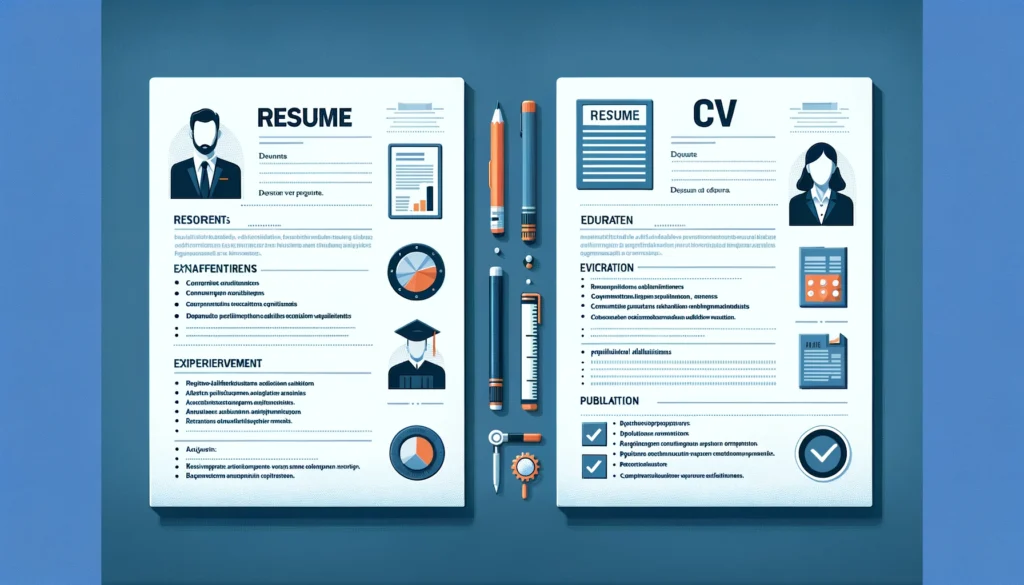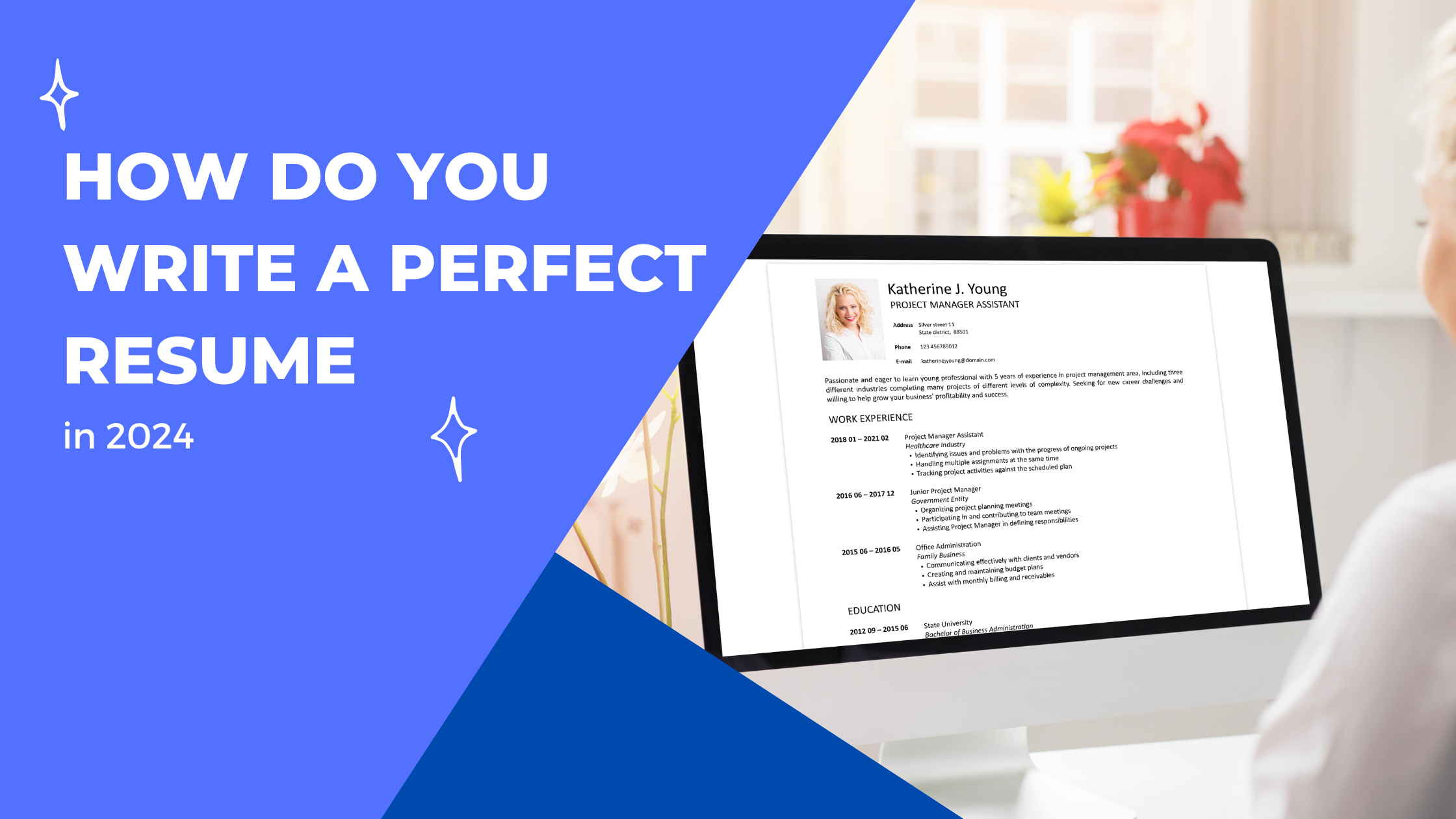You’re about to apply for a new job and you’ve been asked to send your resume. Or was it a CV? What’s the difference you wonder? It’s a common question for job seekers. Let’s break down the meaning of these two terms, and the key differences between CV vs resume and when to use which.
Before we get into the details, let’s define what “resume” and “CV” mean. While both types of document serve the same purpose—showcasing your skills to potential employers—they can be very different in format, length and use.
There are even regional and language nuances where these terms can be used interchangeably. When it comes to CVs and resumes, understanding the key components that set them apart is crucial.
What’s a Resume vs a Curriculum Vitae?
A resume is a term used in North America to describe a short document summarizing your work experience, professional experience, skills, education, and achievements relevant to the job you’re applying for.
It’s used for job search purposes, unlike a CV which is typically used for academic purposes. Think of it as a snapshot of your career, usually one to two pages max, hence the term “resume” which comes from the French word “résumé” meaning “summary”.
What is a CV?
A CV, or Curriculum Vitae, is a comprehensive document that provides an in-depth overview of a candidate’s academic and professional background. It includes detailed sections on research experience, publications, presentations, and other academic achievements.
This makes it particularly suitable for academic positions, research roles, and scientific fields where a thorough record of one’s professional journey is essential.
When to Use a Resume vs CV
A resume is the most common format for applying to non-academic positions such as business, technology, marketing and administration. A resume should be crafted to grab the attention of the hiring manager, showcasing relevant skills, achievements, and professional qualifications relevant to the job you’re applying for.
They can be used for Entry-Level, Mid-Career, Senior Leadership and even Executive roles to showcase relevant skills and experience. Unless you’re applying for an academic, research, medical or highly scientific role, you should be using a resume for your job application..
When to Use a CV
A CV is used when you need a detailed overview of your professional and academic history. A key component of a CV is the professional profile which is a summary of your work experience, educational background and relevant skills. A CV should also reflect your career goals and how your background aligns with the position you are applying for. Here are some common scenarios where a CV would be used:
-
Academic Positions: When applying for academic roles such as faculty positions, research posts or fellowships, a CV is preferred to detail your educational background, teaching experience, research, publications, presentations, awards, honors and other academic achievements.
-
Scientific or Research Roles: Positions that involve scientific research, laboratory work or other research-oriented roles often require a CV to highlight research projects, publications, conferences attended and any relevant work in the field.
-
Grants, Scholarships and Fellowships: When applying for grants, scholarships or fellowships, a CV is usually required to provide a comprehensive overview of an individual’s academic and professional achievements which can be crucial for selection committees.
-
International Jobs: In many countries outside of the United States, a CV is the standard document for job applications regardless of the industry. It’s more detailed than a resume and provides a fuller picture of the candidate’s qualifications.
-
Medical, Dental and Healthcare: Professionals in the medical, dental and healthcare fields often use a CV to apply for positions, detailing their internships, residencies, fellowships, licenses and professional experience.
-
High-Level Executive Positions: For senior-level or executive positions, a CV can be useful to present your lengthy career progression, leadership roles, achievements and contributions to previous organizations.
-
Arts, Performance and Writing: Artists, performers and writers may use a CV to list exhibitions, performances, publications or productions they have been involved with, along with any awards or recognitions received.
CV and Resume Essentials
What to Include on a CV
-
Contact Information: Name, address, phone number, email.
-
Professional Profile: A summary of your professional background and career goals.
-
Education: Education background including degrees, institutions and dates.
-
Work Experience: A detailed list of your work experience including job titles, employers, dates and responsibilities.
-
Skills: Relevant skills that demonstrate your qualifications for the job.
-
Achievements: Notable achievements in your career.
-
Research Experience: Research projects you have been involved in.
-
Publications: Articles, papers or books published.
-
Presentations: Conferences or seminars attended.
-
Awards: Academic or professional awards received.
-
Professional Memberships: Professional organization memberships.
What to Include on a Resume vs CV
A resume typically includes these main sections:
-
Contact Information: Name, address, phone number, email.
-
Professional Summary: Career objectives and key qualifications.
-
Education: Education background including degrees and institutions.
-
Work Experience: Professional background including job titles, employers and responsibilities.
-
Skills: Relevant skills for the job ad.
-
Achievements: Key achievements that demonstrate your qualifications.
And you may also include the following sections as an option if relevant to the job:
-
Volunteer Work: Volunteer experience relevant to the job.
-
Hobbies: Personal interests relevant to the job.
-
Certifications: Professional certifications.
-
Professional Licenses: Licenses for your field.
-
Relevant Projects: Projects that demonstrate your skills and experience.
-
Relevant Coursework: Courses relevant to the job.
-
Relevant Tools or Software: Tools or software you are proficient in.
-
Relevant Languages: Languages relevant to the job.
Regional differences: CV vs Resume
The terms “CV” (Curriculum Vitae) and “resume” are used differently around the world with variations in expectation and format depending on the country and context.
In some countries, you may include personal information such as date of birth, marital status, and even a photo on a CV, which would be unusual and often discouraged on a resume in the US and Canada due to employment discrimination laws.
In the US and Canada:
A “resume” is typically used for most jobs in the US and Canada. It should be brief, typically 1-2 pages long, summarizing your skills, experience and education relevant to the job you are applying for.
In North America a CV is expected to be longer and more detailed, outlining elements such as an individual’s entire academic and professional history. It’s primarily used for applications within academia, education, science or research positions.
There is an exception to this rule in French-speaking Quebec where the term CV is used as in Europe and is asked for most jobs, but most of the time the expectation is actually what is considered a resume.
In Europe, Middle East, Africa and Asia:
The term “CV” is used for job applications in many European countries and other regions and is similar to the American resume in purpose but can vary in length.
It is expected to provide detailed information about your education, work experience, skills and sometimes personal interests and hobbies.
Unlike the American CV it’s used for all job applications not just academic or research positions.
Expectations and Differences:
In places where “CV” is used for job applications (outside of the US and Canada) it may not be as long as the American CV used for academic positions but is generally more detailed than a resume.
In some countries you may include personal information such as date of birth, marital status and even a photo on a CV which would be unusual and often discouraged on a resume in the US and Canada due to employment discrimination laws.
Resumes are highly customized to the job, highlighting relevant experience and skills. CVs where used in the non-academic context outside North America provide a more general overview of your career path without the need to customize for each application.
How to write a great CV or Resume
Writing a great CV or resume is more than just listing your work experience and education. It’s about presenting your skills, achievements and qualifications in a way that stands out in a crowded job market.
Tips for Impressing Hiring Managers
-
Use a Simple Format: Make it easy to read with a clean layout and headings.
-
Customize for Each Job Application: Customize your document to highlight the skills and experience most relevant to the job.
-
Highlight Relevant Skills and Achievements: Focus on the skills and achievements most relevant to the job ad.
-
Use Action Verbs and Keywords: Use action verbs and industry keywords to make your document more dynamic and to get past applicant tracking systems.
-
Proofread: No typos or grammatical errors.
-
Use a Professional Summary: Summarise your most significant achievements and qualifications at the top of your document.
-
Reverse Chronological Order: List your work experience in reverse chronological order.
-
Bullet Points: Break up large blocks of text with bullet points.
-
Relevant Headings: Help recruiters find what they’re looking for with clear and relevant section headings.
Follow these tips and you’ll have a great CV or resume that showcases your skills and achievements and gets you noticed in a crowded job market.
Common Mistakes to Avoid
Creating a CV or resume can be a daunting task, and there are several common mistakes that job seekers should avoid to make a positive impression on hiring managers. One of the most frequent errors is not tailoring your resume to the specific job or industry.
A generic CV or resume that doesn’t highlight relevant skills and experience can fail to capture the attention of hiring managers and may not make it past the initial screening.
Another critical mistake is neglecting to proofread the document carefully. Typos, grammatical errors, and formatting issues can create a negative impression and suggest a lack of attention to detail. It’s essential to review your document multiple times and consider having someone else proofread it as well.
Final Check and Proofreading
Before submitting your CV or resume, performing a final check and thorough proofreading is essential. This step ensures that your document is free from spelling and grammatical errors, formatting issues, and inconsistencies in font and style. A polished and professional document can significantly enhance your chances of making a positive impression on hiring managers.
Consider enlisting the help of a certified professional resume writer or a career counselor to review your document. These professionals can provide valuable feedback and ensure that your CV or resume effectively highlights your qualifications and is tailored to the job you’re applying for. Their expertise can help you present your professional profile in the best possible light.
So, resume vs CV?
As a general rule if you’re applying for jobs outside of academia in the US or Canada a resume is fine. But for academic, research or scientific roles a CV is more suitable.
Whatever you choose make sure it communicates your qualifications and sets you apart from other candidates. You can use the Careerpilot AI Resume builder to build your resume or CV. Whether it’s a resume or a CV your goal remains the same—get your dream job.
Conclusion
In conclusion, understanding the differences between a CV and a resume is crucial for job seekers. A CV is a comprehensive document that showcases a candidate’s academic and professional background, making it ideal for academic, research, and scientific roles.
In contrast, a resume is a concise document that highlights relevant skills and work experience tailored to a specific job, suitable for most non-academic positions.






